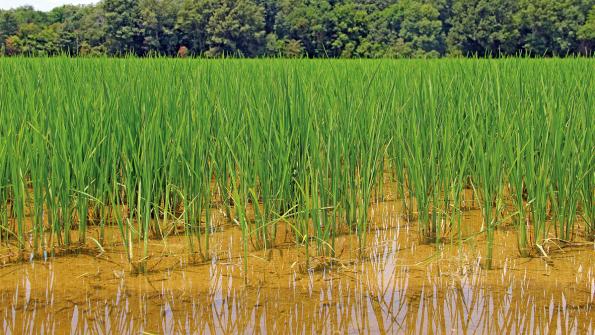
High nighttime temperatures a concern for rice producers
“The overwhelming concern at this point has to do with the daytime and nighttime temperatures,” Dr. Hardke said. “We have had an unfortunate run of nighttime temperatures that are remaining at or above 75 degrees at night, and we know from a decade of research that that can have a significant impact on grain quality, primarily related to chalkiness.”
July 28, 2015

The Arkansas rice crop is making good progress, especially if you consider what it endured at the beginning of the 2015 season, says Jarrod Hardke, Extension rice specialist with the University of Arkansas.
But weather continues to be a major factor, particularly the high nighttime temperatures that have been occurring in the state’s rice-growing areas and much of the Mid-South Rice Belt. Dr. Hardke spoke on the current agronomic outlook for the Arkansas rice crop during the University of Arkansas’ Food and Agribusiness Webinar on July 22.
“The overwhelming concern at this point has to do with the daytime and nighttime temperatures,” Dr. Hardke said. “We have had an unfortunate run of nighttime temperatures that are remaining at or above 75 degrees at night, and we know from a decade of research that that can have a significant impact on grain quality, primarily related to chalkiness.”
Looking back at the two most recent problematic years from the standpoint of grain quality – 2010 and 2011 – Arkansas’ nighttime temperatures did not get below 75 degrees for a period of 25 to 30 days spanning across July and early August.
“Those are the types of conditions we’re looking at for the moment, and we hope we can get out of because we don’t want to have similar grain quality as in those years,” he said. “In addition, we also had problems with bacterial panicle blight in those years, which we may be at risk from especially for the part of our crop that was pushed into a later-planted window.”
Some of Arkansas’ rice crop was not planted until June due to the incessant rains that fell across the state in April and May. June plantings appear to increase the risk of bacterial panicle blight.
On a more positive note, he said some of the newer varieties being grown in the state currently do not appear to be as susceptible to bacterial panicle blight as varieties that were being grown in 2010 and 2011.
“In 60 percent of the acreage being grown in Arkansas this year, the cultivars would be rated moderately susceptible or better to bacterial panicle blight,” he noted. “When I say better, I mean moderately susceptible to resistant. In 2010 and 2011, that number was only about as high as 40 percent.
“So we’re in a little safer area than we were then if we do have some issues with it,” says Hardke.
Incidences of other traditional rice diseases – sheath blight and leaf blast – appear to have gone down because of the higher temperatures. “That is one bonus for this time of year,” he said. “But if I’m also talking about bacterial panicle blight, it doesn’t make people feel that much better about things.”
Hardke says he feels comfortable with USDA’s projection of 1.39 million planted acres for Arkansas’ 2015 rice crop. “I had thought initially our medium grain acreage might be slightly higher than the 240,000 in the June USDA Acreage Report, but that is, in fact, close to the numbers I have at this time.”
Farmers still have a “long way to go to make this crop,” said Hardke. “We do have problems with grass escapes that are being cleaned up and some that are beyond the point of being cleaned up. My concern is that if we have fall weather with high winds and a lot of grass escapes like these that they will start to lodge the rice.”
And growers are not likely to repeat the record yields of the last three years, he said. “I think we will probably be in the upper 150s (bushels per acres) is where I feel comfortable at this point. That would be down from the 168-bushel average of the last two years. 2015 has certainly been a much tougher year than the last two, particularly in getting it planted this spring.”
To hear Dr. Hardke’s comments, go to https://www.youtube.com/watch?v=BYXvUl96IxQ&feature=youtu.be&t=40m55s
About the Author(s)
You May Also Like





